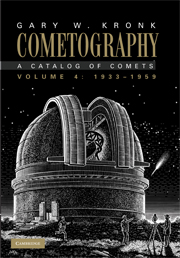Summary
C/1933 D1Discovered: 1933 February 16.1 (Δ = 0.60 AU, r = 1.01 AU, Elong. = 75°)
(Peltier)Last seen: 1933 April 14.21 (Δ = 1.52 AU, r = 1.49 AU, Elong. = 68°)
Closest to the Earth: 1933 February 23 (0.5575 AU)
1933 I = 1933aCalculated path: CEP (Disc), CAS (Feb. 17), PER (Feb. 23), TAU (Mar. 8), ORI (Mar. 18)
L. C. Peltier (Delphos, Ohio, USA) was involved in a routine comet-sweeping session on 1933 February 16.1, when he came across an object of magnitude 8.6 at α = 22h 48m, δ = +62°. He immediately wired G. van Biesbroeck (Yerkes Observatory, Wisconsin, USA) for confirmation, but cloudy skies were prevalent. Peltier sent a telegram to Harvard College Observatory (Massachusetts, USA) the next morning announcing his discovery. Confirmation came on February 17.05, when van Biesbroeck detected the comet in hazy skies. He described it as 9th magnitude, with a round centrally condensed coma 5′ across. H. M. Jeffers (Lick Observatory, California, USA) independently confirmed the comet with the 30-cm refractor on February 17.23. He estimated the magnitude as 9, and said the centrally condensed coma was 2′ across, but contained no stellar nucleus. Additional confirmation came on February 17.81, when R. Carrasco (Madrid Observatory, Spain) estimated the photographic magnitude as 8. The comet attained its most northerly declination of +62° on February 17. The comet was discovered a few days after it had passed perihelion, but was approaching Earth.
- Type
- Chapter
- Information
- CometographyA Catalog of Comets, pp. 1 - 588Publisher: Cambridge University PressPrint publication year: 2008
- 10
- Cited by

